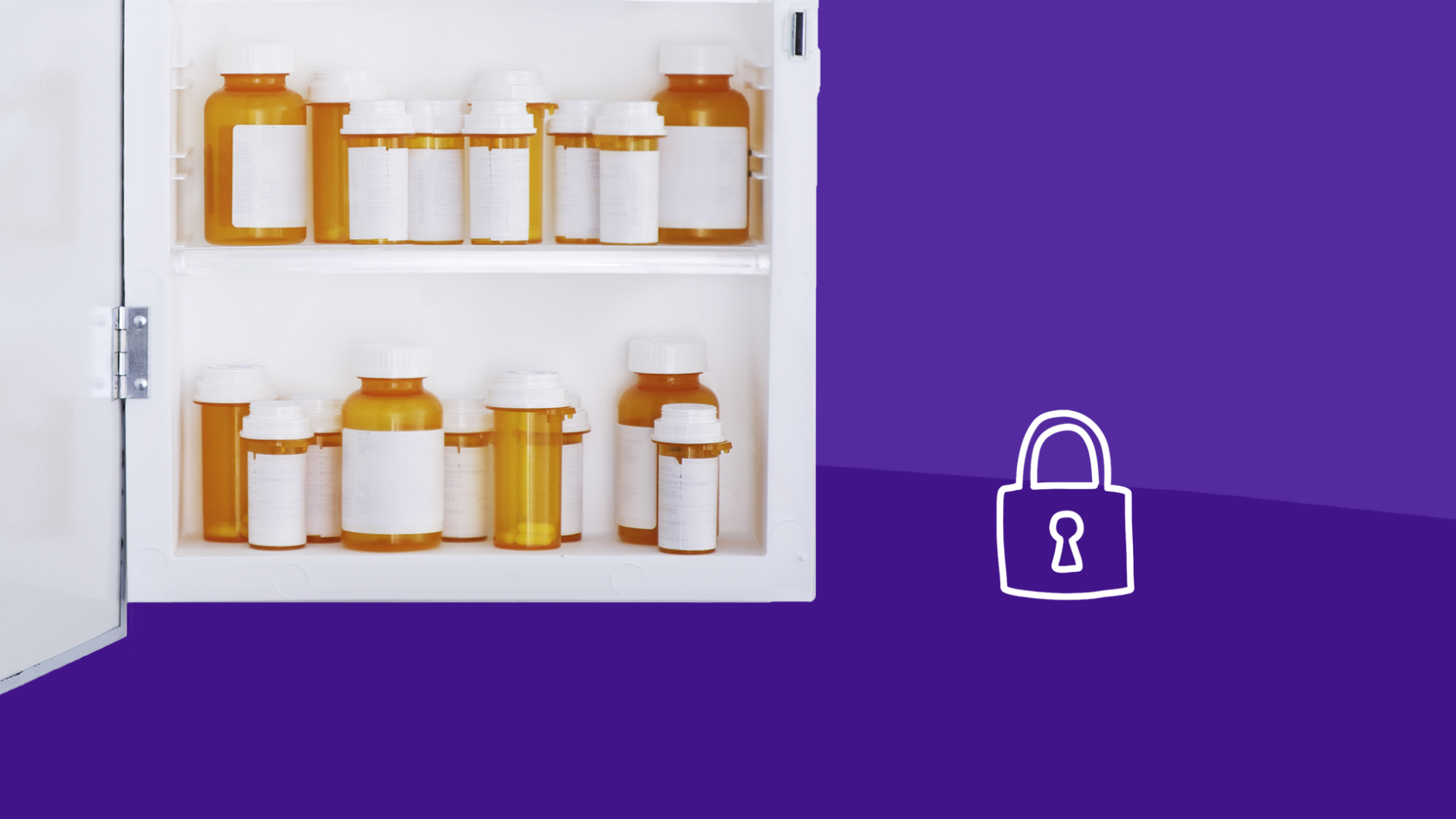Key takeaways
Each year, 35,000 children under the age of 5 visit the ER due to unsupervised ingestion of medication, highlighting the need for secure storage to protect both kids and pets.
Following the “5 R’s” for medication safety (Right drug, Right dose, Right time, Right route, Right person) is crucial in preventing accidental harm when administering medication to children or pets.
Medications should be stored in a locked box on a high shelf in a common room, and not mixed with food unless advised by a healthcare professional, to ensure safety.
Educating children about the dangers of medication and ensuring pets do not have access to any ingestible items are key steps in preventing accidental overdoses.
Medications are powerful substances that can drastically improve our health. They also have the power to hurt when used incorrectly or in the wrong hands.
“As a parent, you have to always remember that children are curious and natural explorers,” says Mary Sweeney, RN, a medical consultant for parenting website Mom Loves Best. “They’ll look in any drawer or cabinet they can. The same is true for pets. They can be curious as well and surprisingly clever about getting into places you think they don’t know about or can’t reach.”
Kids and pets don’t understand what’s okay to eat and what’s not. They see you taking pills and swallowing them, so why shouldn’t they?
And if your children or pets actually do need medication, you have to assume the role of nurse and give it to them. Different medications require different dosages, and need to be administered at different times. Even in hospitals, mistakes happen.
Whether from their own curiosity or a mistake by a parent or caregiver, 150,000 children ages 17 and younger arrive at emergency rooms each year due to adverse drug events. Of these, around 35,000 are children younger than five who ingested medicine while unsupervised. An estimated 70% of visits for unsupervised ingestion of medications are for one- or two-year-olds.
These numbers reveal a hard truth about how important it is to take extra care with medicines in your home. Knowing the proper way to store and administer medication with children or pets in your household can end up saving a life.
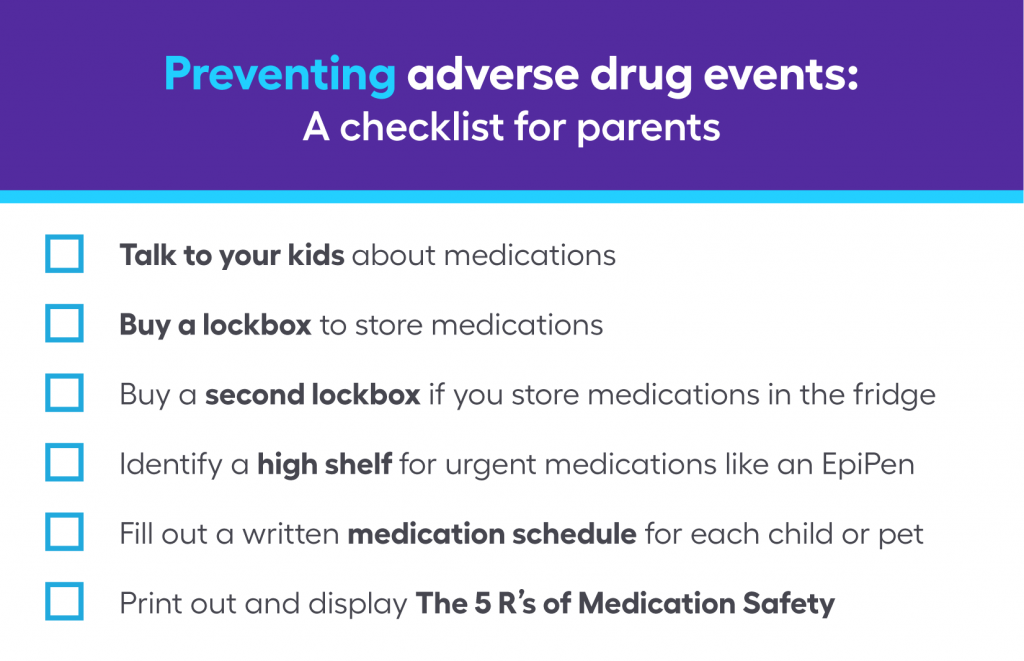
What is home medication safety?
Home medication safety is the practice of making sure that:
- The human/animal who is prescribed or directed to take medication is the only one who takes it.
- The human/animal takes the medication exactly the way their medical professional or the directions for over-the-counter medications intends.
Home medication safety helps to protect you, your children, and your pets from harm that comes when medicines aren’t taken properly.
Why is medication safety important?
According to the Centers for Disease Control and Prevention, adverse drug events (ADEs) cause more than 1.3 million emergency room visits per year. Of those, 350,000 people per year are hospitalized. ADEs are estimated to cost our healthcare system an extra $3.5 billion per year.
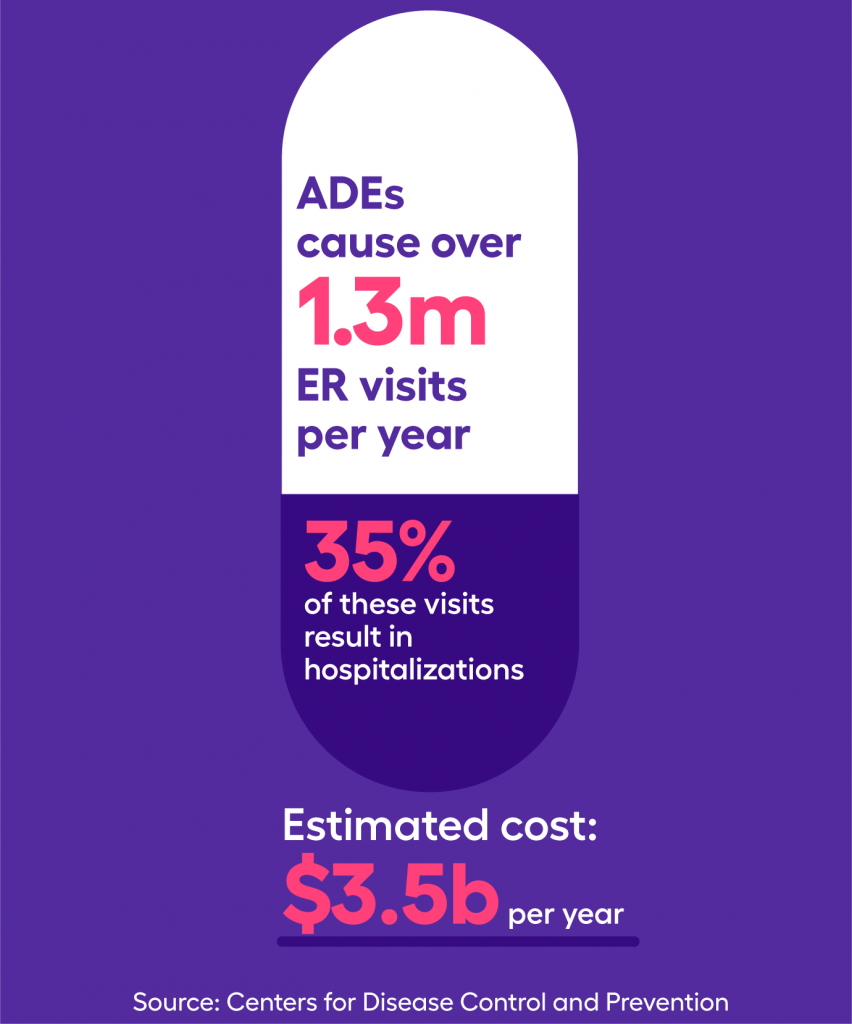
Why are these events so frequent? Simply put, the introduction of new, helpful medications means we’re taking more pills. When we have more medications to take (or give to a child or pet), there’s a higher chance we’ll accidentally use the wrong medication or the wrong dose.
Another possible cause for adverse events is related to the high use of over-the-counter medications. Many of these medications are combination medicines, with several ingredients mixed together for convenience. When someone takes an over-the-counter cough syrup, for example, but doesn’t know that it contains a pain reliever, they may be at risk of an overdose if they’re also taking the pain reliever as a separate medication.
What are the 5 R’s for medication safety?
Following the 5 R’s for medication safety is the best way to make sure you don’t accidentally harm your child or pet when giving them medication.
- Right drug
- Right dose
- Right time
- Right route
- Right person
Hospitals follow these exact steps when they give medication to patients.
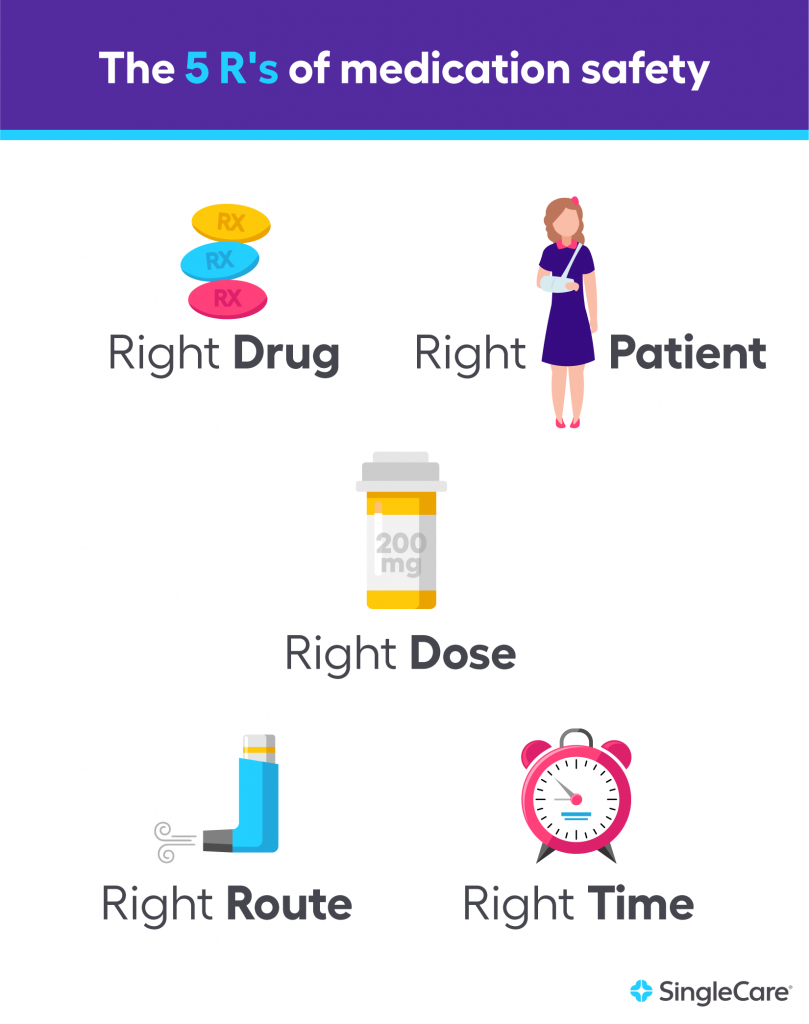
Right drug
Even if you’re sure you are grabbing the pill bottle that’s right where you left it, someone else in the house may have moved the bottles around. Make a point to look at the pill bottle, then read the name of the drug out loud.
Look at the individual pill or liquid inside to see that it looks familiar. Is it the same color, shape, and size as what you’re used to taking? While pharmacies can sometimes use medicines that look slightly different, a phone call to your pharmacist can clear up any misunderstanding and help you know that it is, in fact, the right medication to take.
Right dose
One of the most common causes of adverse drug events comes from giving improper doses—usually when people misread or mismeasure the medication amount.
Dosing pills should be simple enough: Just double-check the amount. Sometimes half-pills are prescribed especially when the medication is being given to children or pets. This should be clearly marked on the bottle.
Liquid medications can be more challenging because you have to measure the amount yourself. These prescriptions sometimes come with less familiar metric measures (like milliliters).
Use the dosing spoon or dropper that came with the medicine, and tell your pharmacist if you are unsure how to use it or if you don’t have one. While many medications don’t come with dispensers, having the right dispenser can help you dose the medication correctly. Liquid medications often include them for free.
Using your own spoons from home comes with risk, as your spoon may not be designed to provide an accurate measurement. Using a dropper or spoon made specifically for medicines reduces the chance you will make a costly mistake.
Right time
Because different medications are used to treat different things, it makes sense they would work best at different frequencies. But this can make administering medications confusing.
Some medications are taken once per day, others early in the morning and late at night, and still others, consistently throughout the day. Following these instructions will help your child or pet get well faster. Accidentally messing up the timing could make them worse.
The best solution is a written medication schedule. Having everything written down chronologically will help you avoid mistakes. If there are multiple people administering medications, a printed schedule will ensure everyone is working with the same information.
If you need help remembering when to administer medications, set alarms on your cell phone tied to the times that are listed on the schedule. A few minutes of setup can save you from missing a dose of medication your child or pet needs.
Right route
Double-check and say out loud where the medication must go, especially for eye drops or ear drops.
Most pills are given orally—which can be an ordeal with fussy children. The simple fix of mixing the medication with food is a bad idea. “It is usually best not to mix medication with food or drink because it might interfere with the medication’s effectiveness or dilute the dose,” according to the American Academy of Pediatrics. “Ask your child’s doctor or pharmacist before mixing medication with food or liquid.”
To ensure you’re following the right route, be firm. Direct them to swallow the entire pill as intended, and wait until they do. If they continue to refuse, call your doctor or pharmacist for advice that’s appropriate for the specific medication you’re trying to administer.
With pets, pairing medication with food may be the only way to get them to take it. When your veterinarian prescribes pills or liquid medication, ask for advice about the best way to make sure your pet gets the correct dose.
Right person
When you have multiple people or pets taking medication, it’s easier than you’d think to give a drug to the wrong person. As a last step before administering the medication, look again at the medication you’re holding to make sure you’re giving it to the right patient.
If you have several people in your home taking medication at the same time, use a checklist to mark off each person and medication as they are given. Don’t expect children to remember if they’ve taken their medication that day. Some children may like the taste of their medication enough to ask for more, but don’t put this responsibility on them.
How do you keep medicines safe?
There are a few ways to store medications safely:
- Keep medications in a locked box.
- Keep the locked box on the highest shelf you can.
- Make sure the shelf is in a common room like the kitchen, not a lockable one like a bathroom.
Do you need a medication lockbox?
You need a medication lockbox if you have children or pets in your home, and you have no other way of locking away medications. If your home has a lockable cabinet that is out of reach for your children, that would work, too.
There are exceptions, notes Sweeney. “If you need frequent or easy access to your medication, such as an EpiPen for life-threatening allergies, it may not be safe for your medications to be under lock and key,” she says. “In that case, put the medications up as high as possible.”
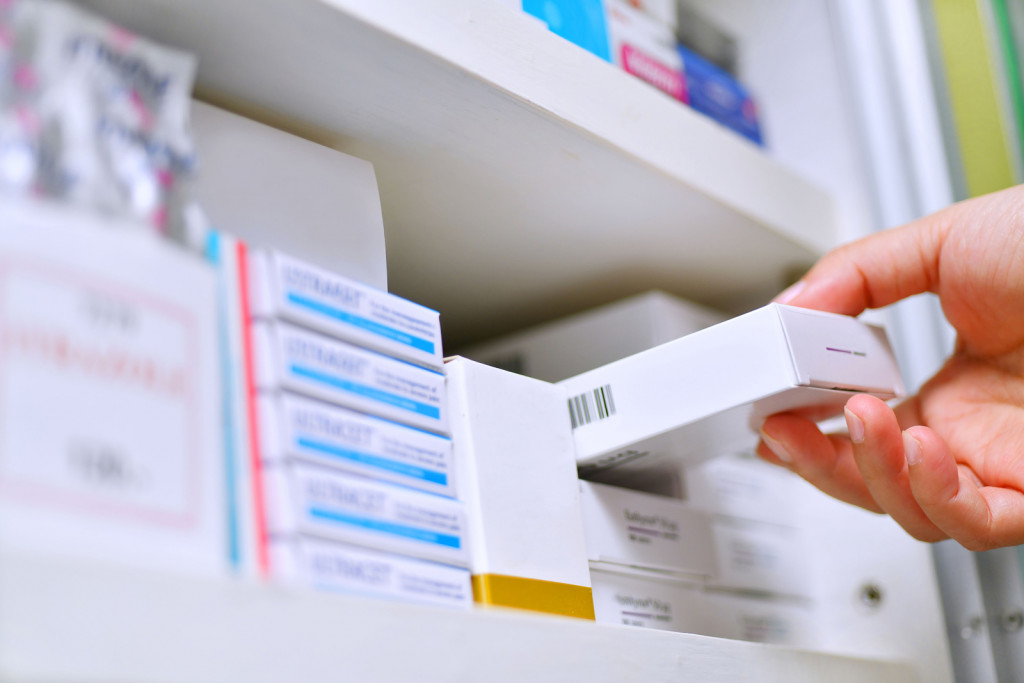
Sweeney also notes that medicine cabinets in bathrooms aren’t very high, and children can easily get to them on a chair or from the top of a counter. Children can also lock themselves in the bathroom, so you can’t see what they’re doing. “Consider putting the medication on the highest shelf you have in your bedroom closet or kitchen cabinet instead,” she says.
Is it okay to keep medicine in the fridge?
Only keep prescription medications in the fridge if the pharmacy recommends it. If you have children, buy a lockbox especially for these medications, and store it in the fridge. The extra expense is worth avoiding the risk of accidental overdose by children looking for food.
Where can you get a childproof medicine cabinet?
A childproof medicine cabinet is one that comes with a lock and key. Ask for one at your local home improvement store.
The childproof locks available for medicine cabinets aren’t adequate to protect against the dangers of accidental drug overdoses. As your children age, they will learn to open these locks.
As mentioned above, you can also buy a medication lockbox to safely store medications.
What can we do to make a home safe for children in relation to medication?
There are two important things you can do to keep your home safe for children when it comes to medication:
- Make sure your children can’t get to any medications—including vitamins and ointments.
- Talk about medications with your children—the right way.
Keep all medications secure. If you don’t have a lockbox, buy one—and in the meantime, store the medications on the highest shelf in your home. Also, ask your pharmacist to provide child-resistant caps. You can also get lids that are made to lock pills, but you have to take the pills out of their original bottle with the prescription information on it. This can result in confusion when administering pills, so keeping the original bottles safe is the best option.
“If you keep medication in your purse, you should place your purse on a high shelf when you aren’t carrying it,” says Sweeney. “If your child likes to look around in your purse, you need to teach them your purse is your private property and they aren’t to look in there.”
Remember: Just because a bottle, vial, or case is sold over-the-counter doesn’t mean it’s not dangerous. Protect your kids from their own curiosity by keeping these items out of their reach at all times.
Also, dispose of extra or unused medications safely. The chance they will come in handy someday is not worth the risk of a child or pet accidentally ingesting them.
And, no matter how many safety precautions you take, keep the Poison Control hotline number prominently displayed in your home. The number is 800-222-1222, and it connects you to a local poison control center in case of an accidental overdose. They will help you decide what to do next.
Talking to kids about medication
Let’s start with what not to say to your children about medication. Never tell a child that medication is “candy” or that “you’ll like it” in an effort to get them to take it.
If they think medication is candy (or if they’re taking drugs that look like candy), they will want more, and they could end up taking something that makes them sick.
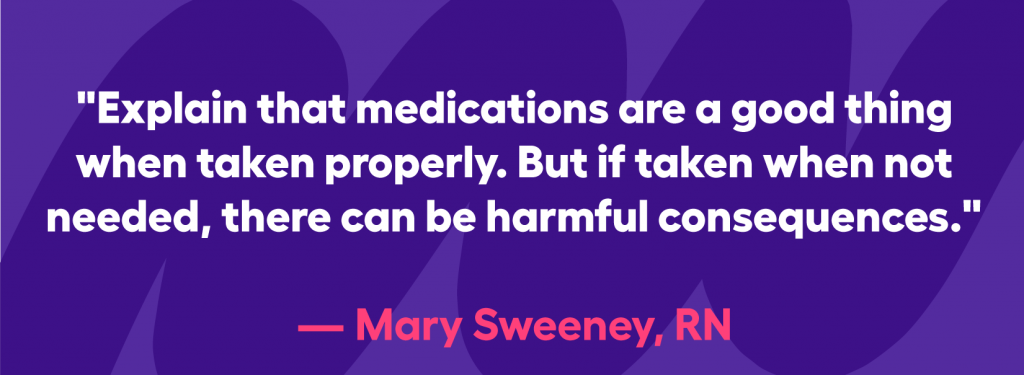
Tell kids the truth about medications. “Explain that medications are a good thing when taken properly,” says Sweeney. “But if too much is taken or it is taken when not needed, there can be harmful consequences.” This medicine safety coloring book can help you get the conversation started.
Kids love to mimic their parents, so if they see you taking medication, they may want to try it. Sometimes, children will say they have a headache or stomachache so they can get a taste of the pills their parents use. Make sure you see actual symptoms of an illness before giving your children medication to treat it. Also, consult a doctor or pharmacist to ensure that the medication is appropriate for their age.
What can we do to make a home safe for pets in relation to medication?
The most important thing you can do to keep your home safe for pets when it comes to medication? Don’t give it to them unless directed by a veterinarian.
“Pets are not small children,” says Sara Ochoa, DVM, a small animal and exotic veterinarian in Texas and veterinary consultant for doglab.com. “Do not give them human medication without talking with your vet. This could be dangerous and even deadly.”
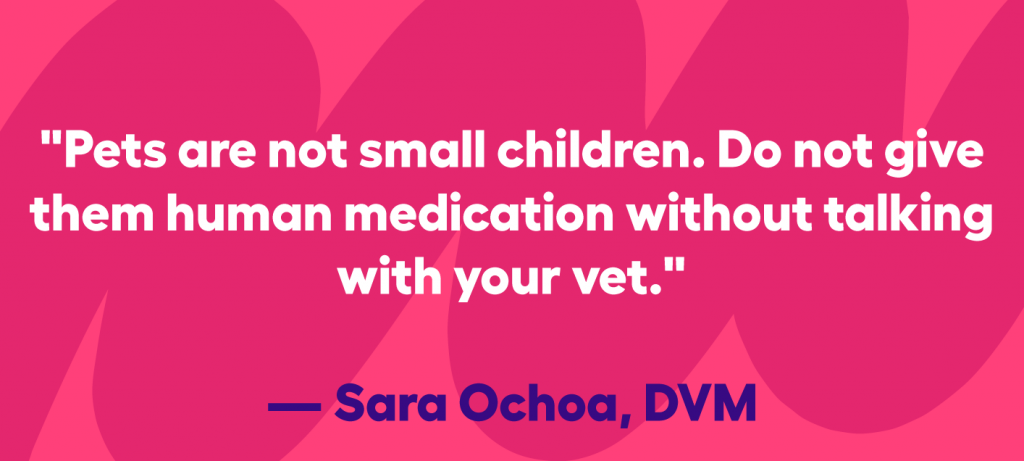
Yes, some prescription and over-the-counter medications are safe for animals. Some dogs are prescribed Prozac, for example, and short-term anxiety medications can be a good solution for your pet’s fear of fireworks. But don’t make this call on your own. No amount of online research is a substitute for your vet’s years of training. Call and ask them before you do something that makes your pet’s problem worse.
Keep pets away from everything they might eat
The other most important thing? Keep medication and medical equipment safe from the indiscriminate foraging that pets often do. With pets, anything can happen, and often does.
Kassandra Nielsen, DVM, a veterinarian at October Road Veterinary Services in Woodstock, Connecticut, has removed Legos, baby pacifiers, Nerf darts, and even a baby Jesus from the stomachs of pets. One recent horror story she shares describes a pet owner hearing a loud pop and hissing sound, and looking up to see her Australian cattle dog chomping on her son’s albuterol inhaler.
“Even a small amount of albuterol can cause life-threatening side effects,” Dr. Nielsen says. “From mild ones like agitation and tremors, to more serious ones like dangerously high heart rates, high blood pressure, and seizures. The dog spent 24 hours in the hospital until her heart rate and blood pressure stabilized.”
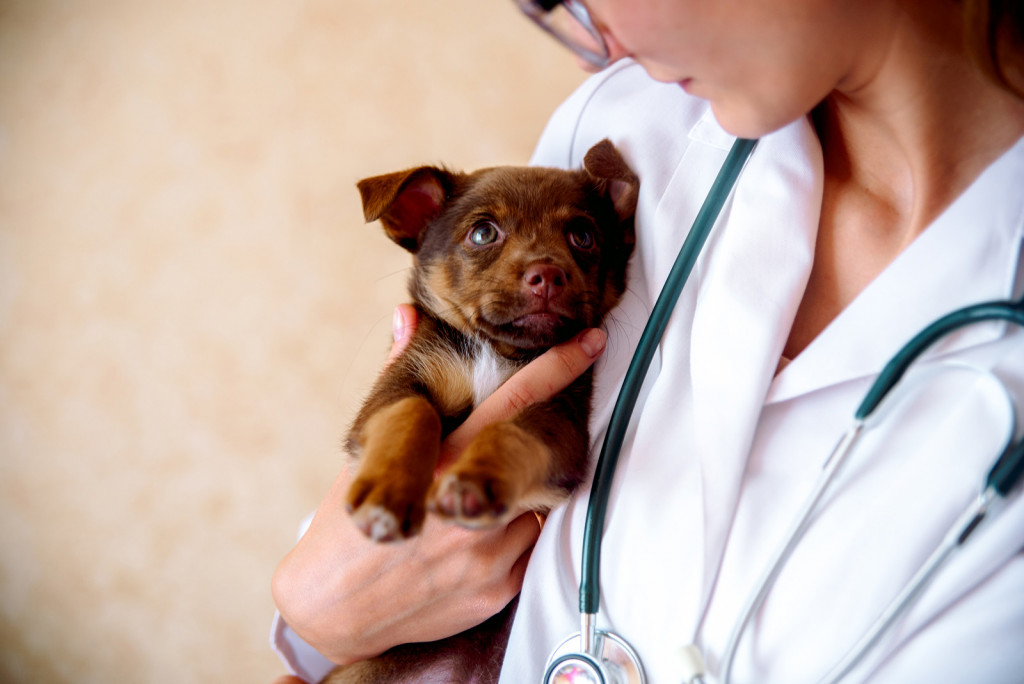
Make sure all of your medications are on the highest shelf you have, and out of reach of your curious pets. Again, a lockbox is an excellent precaution that means you’ll never have to worry about an accidental overdose by your pet.
Simple precautions give you outstanding protection against adverse drug events
Protecting your kids and pets from accidental overdoses is important and easy. Follow the 5 R’s when you administer medication, and when you’re done, lock away that medication. It’s a small investment of time, attention, and money that will give you ample peace of mind.




